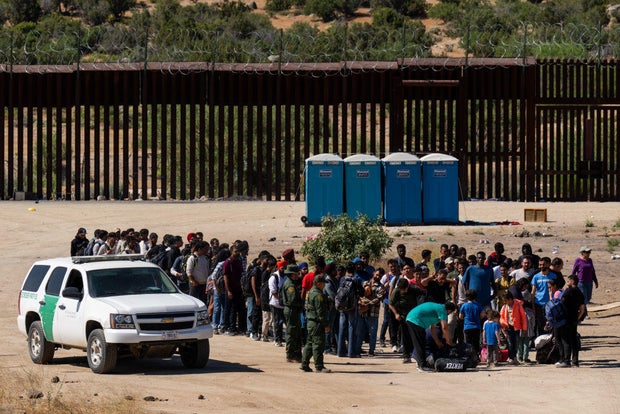The Biden administration is debating changes that would make it harder to lift the sweeping asylum restrictions it enacted in June, drafting plans to alter the criteria that would be used to deactivate the strict border measure, two Department of Homeland Security officials told CBS News.
The proposed changes concern a proclamation issued in early June by President Biden that has effectively shut down access to the American asylum system for migrants crossing the U.S.-Mexico border illegally. Officials have credited the crackdown, the most restrictive asylum policy by a Democratic president, for a four-year-low in unauthorized border crossings.
Mr. Biden’s asylum ban included a deactivation trigger, in which the policy would be discontinued if the seven-day average of daily illegal border crossings fell below 1,500. Under the proposed changes, the asylum restrictions would only be deactivated if the seven-day average of unlawful border crossings stay below 1,500 for 28 days, the DHS officials said, requesting anonymity to discuss internal deliberations.
The changes being drafted would also include more migrants in the calculations used for the deactivation threshold. Currently, the calculations don’t include crossings by unaccompanied migrant children who are not from Mexico. The updated calculations would include crossings by all unaccompanied children.
Those changes, if approved, would be enacted through regulations by the Department of Homeland Security and the Justice Department. In June, the departments issued an interim regulation to implement Mr. Biden’s decree. As part of the standard regulatory process, the departments are working on a final rule.
Luis Miranda, a DHS spokesperson, said officials “are continuing to process comments received relating to the Interim Final Rule published on June 7, 2024.”
“We cannot comment on the content of a rule that is not yet final nor issued,” Miranda added.
Biden’s asylum order
Qian Weizhong/VCG via Getty Images
The June proclamation has ushered in a seismic shift in U.S. border policy. For the past several years, many migrants were released into the U.S. interior with court notices — a practice officials see as a “pull” factor that encourages migration — because the government did not have enough personnel and resources to detain and immediately screen everyone for asylum.
Since the new rules took effect, fewer migrants are being released into the U.S. and allowed to apply for asylum in immigration court. Moreover, a higher percentage of those crossing into the U.S. illegally are facing expedited deportation to Mexico or their home countries.
While they were declining since the beginning of the year, mostly due to the Mexican government’s efforts to slow U.S.-bound migration, unlawful border crossings along the American border plunged after Mr. Biden’s directive was announced.
In fact, in July, when illegal border entries dropped to 56,400, the lowest point since Sept. 2020, the average of daily migrant crossings almost reached the deactivation threshold for Mr. Biden’s proclamation. In August, unauthorized crossings rose slightly to 58,000, but remained at a four-year low, according to preliminary government data.
Mr. Biden’s order signaled a dramatic pivot by a Democratic president who came into office pledging to oversee a more “humane” immigration system and reject Trump-era policies that severely restricted asylum. But after three years of record interdictions of migrants at the U.S.-Mexico border and the accompanying political backlash, the Biden administration has embraced broad asylum limits.
In 2023, the administration issued a rule presuming that most non-Mexican migrants are ineligible for asylum because they traveled through at least one third country before crossing into the U.S. illegally. Mr. Biden’s order in June rests on the same legal authority that former President Donald Trump invoked to enact a similar ban on asylum claims. The American Civil Liberties Union has challenged both policies.
At the same time, Mr. Biden, unlike his predecessor, has paired those asylum restrictions with programs that allow tens of thousands of migrants to enter the U.S. legally each month.
One of the policies distributes 1,500 daily appointments to migrants waiting in Mexico so they can be processed at official border entry points. The other program allows up to 30,000 migrants from Cuba, Haiti, Nicaragua and Venezuela to fly to the U.S. on a monthly basis if they have American financial sponsors.

